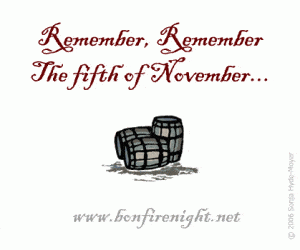
Downton Abbey’s Season 3 finale was broadcast on ITV last night. So ends another chapter following the inhabitants of the great house in the country. There will be much discussion as to how this season ranks against the other two. I am pondering that question myself. But generally it is a sad day around the UK as the Sunday night “Downton Day” ritual has come to an end. But wait! A Christmas episode awaits for the second year in a row. Something to look forward to. Besides, it is Guy Fawkes Day, also known as Bonfire Night. A time for family, friends and community to gather in celebration of a grand failure.

Guy Fawkes Day is celebrated across the United Kingdom marking the failed attempt of Guy Fawkes to blow up English Parliament on November 5, 1605. Bonfires were set alight on that night when the plot was revealed, celebrating the safety of the King James I and the tradition has continued. For four hundred years, the anniversary is commemorated fireworks and burning effigies of Guy Fawkes on huge bonfires, and of course lots of warming foods and drinks.
The Gunpowder Plot

Guy Fawkes was part of a group of 13 Catholic conspirators who plotted against James I, who was less tolerant towards the Catholic religion than this Mother Elizabeth I who had died a few years earlier.
The plan was to blow up the House of Lords, killing the King. Barrels filled with gunpowder were stored in a cellar just under the House of Lords. When it became apparent that innocent people might be killed, an anonymous letter sent to Lord Monteagle warning him to stay away from Parliament on November 5th reached the King.
Guy Fawkes, who was in the cellar of the parliament with 36 barrels of gunpowder when the authorities stormed it in the early hours of November 5th, was caught, tortured and executed.
The Gunpowder Plot had a profound effect. Since then reigning monarchs only enter Parliament once a year for the State Opening of Parliament. According to custom, the Yeomen of the Guard search the cellars of the Palace of Westminster prior to the opening.
Food and Drink
With every celebration comes traditional foods and drinks. Popular foods for this outdoor event include toffee apples, bonfire toffee and potatoes baked in the ashes of the fire. There are often warm soups on hand as well as hot chocolate for the kids, hot toddy for the adults.
Yorkshire Parkin
Parkin holds court as traditional favorite. Guy was from Yorkshire, hence the name. It is a moist sticky cake similar to gingerbread. It contains whole wheat flour and rolled oats so does have some health benefits. I cut the fat in my version, but you can’t escape the sugar in the treacle and golden syrup which gives it the distinctive flavour and texture.
Try using parkin to create an autumnal version of English trifle.
The Amazing Flavours of Yorkshire Parkin
Ingredients
- 2 cups whole wheat flour
- 1/2 tsp. salt
- 4 tsp. ground ginger
- 2 tsp. ground nutmeg
- 1 tsp. ground mace
- 2 cups rolled oats
- ½ cup black treacle (molasses)
- ½ cup golden syrup
- ¼ cup applesauce
- 2 tsp. baking soda
- 1 ¼ cups warm milk
- 1 large egg lightly beaten
Instructions
- Preheat oven to 325 F.
- Mix together flour and spices. Stir in the rolled oats. Gently melt treacle, golden syrup and applesauce over low heat. Make a well in the center of flour mixture and pour in melted ingredients.
- Dissolve baking soda in warmed milk and add to mixture, And then add the egg. Mix to a soft batter and pour into a greased square 9 x 9 pan.
- Bake for 40 minutes.
- Your parkin should be an even brown color and have shrunk away slightly from the sides of the pan when properly baked.
- Leave to cool on a wire rack. Although you can eat the cake right away, it gets stickier and more flavourful if you wrap and store it for several days. Stored in an airtight container and it will keep for weeks.
- Serve on its own as squares, or as a cake with your favorite whipped topping. You know me, I love non fat greek yoghurt sweetened with honey.


